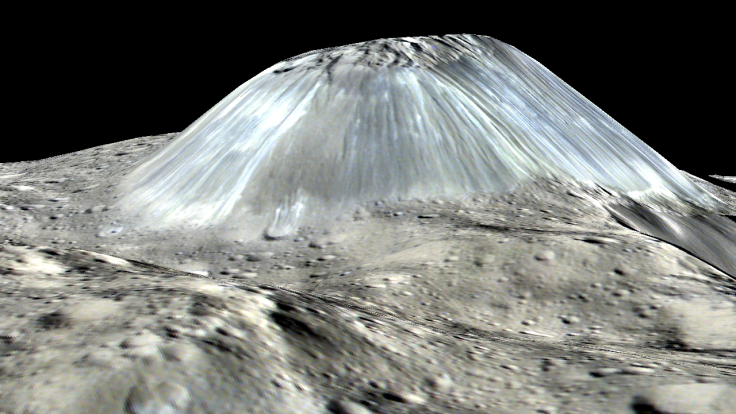Dwarf Planet Ceres’ Lonely Mountain Ahuna Mons May Actually Be A Massive Ice Volcano

NASA’s Dawn spacecraft has been orbiting Ceres — a 600 mile wide dwarf planet in the asteroid belt — since March 2015. Since then, it has become evident that the dwarf planet has a plethora of intriguing geological features, such as a clump of bright spots located in Occator Crater, permanently shadowed regions that may still have deposits of water-ice, and Ahuna Mons — volcanic dome unlike any seen elsewhere in the solar system.
Now, six new studies published this week in the journal Science have shed further light on the mysteries of Ceres. One of them, based on formation models of volcanic domes, 3D terrain maps and images from Dawn and analogous geological features elsewhere in our solar system, posits that the 13,000 feet high Ahuna is most likely a cryovolcano — a volcano that erupts molten and salty water-ice.
“Ahuna is truly unique, being the only mountain of its kind on Ceres. It shows nothing to indicate a tectonic formation, so that led us to consider cryovolcanism as a method for its origin,” co-author David Williams, associate research professor at Arizona State University’s School of Earth and Space Exploration, said in a statement. “Ahuna has only a few craters on its surface, which points to an age of just couple hundred million years at most.”
So why is the possible discovery of cryovolcanism on Ceres significant?
For one, it confirms that although Ceres’ surface temperature averages almost minus 40 degrees, its interior is still warm enough for liquid water to exist for a relatively long period, allowing volcanic activity at the surface.
“Ceres appears differentiated internally, with a core and a complex crust made of 30 to 40 percent water ice mixed with silicate rock and salts,” Williams said. “We need to continue studying the data to better understand the interior structure of Ceres.”
Dawn will continue to study the dwarf planet for at least another year. Scientists hope that by observing Ceres during its closest approach to the sun — perihelion — in April 2018, they’d be able to observe significant changes, and even volcanic activity, triggered by the rise in temperature.
© Copyright IBTimes 2025. All rights reserved.





















